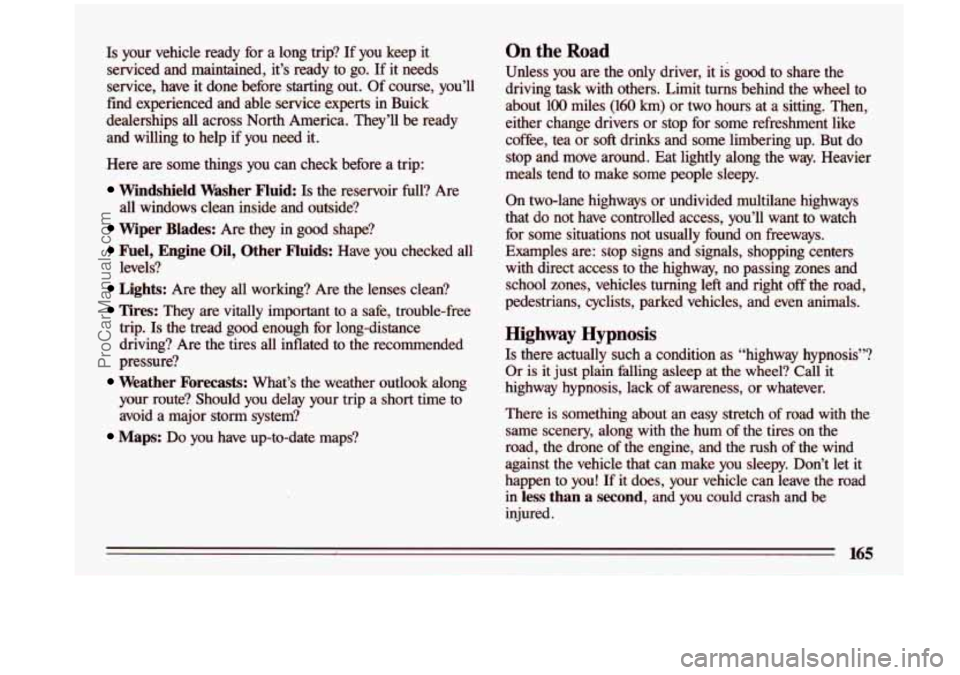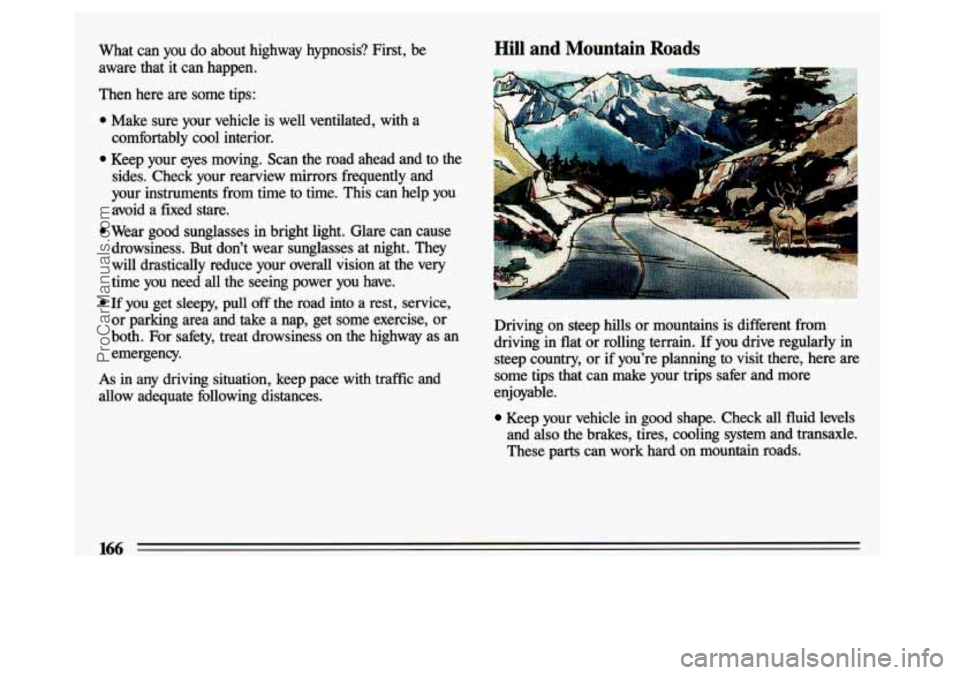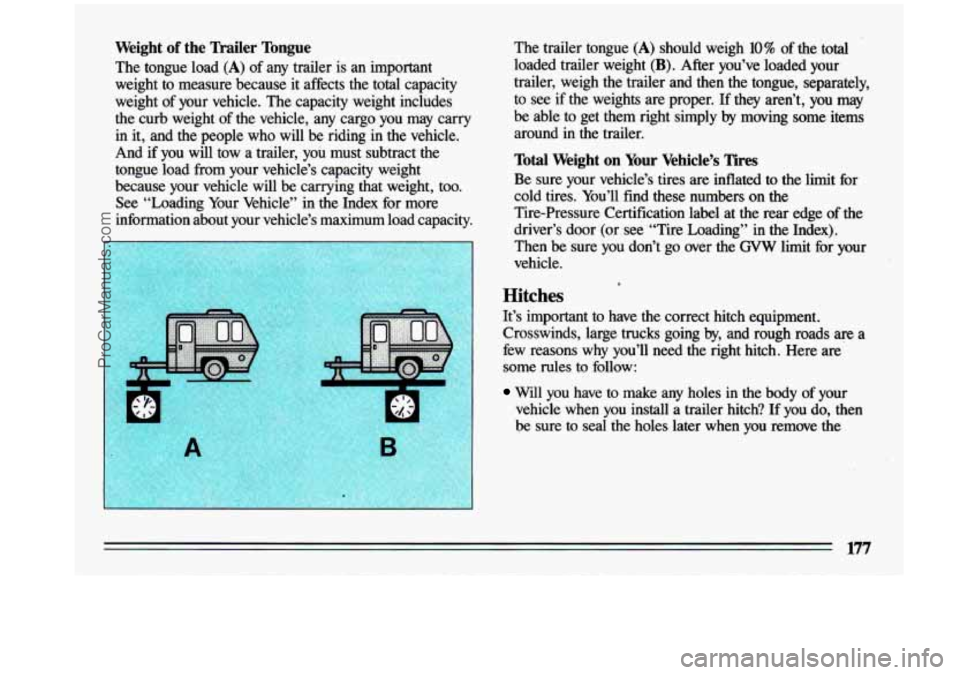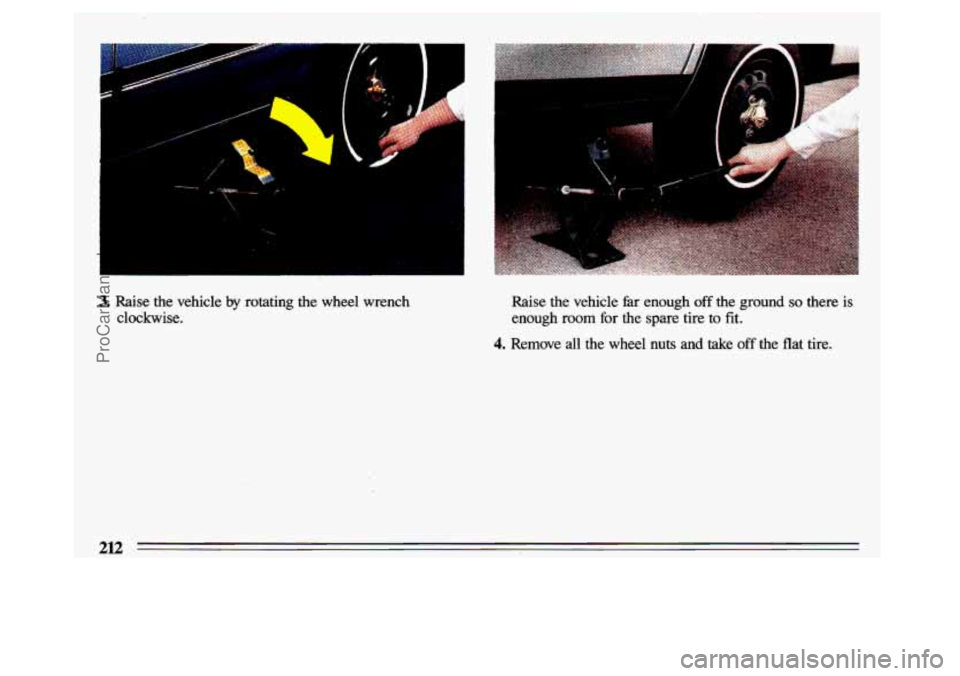1993 BUICK CENTURY flat tire
[x] Cancel search: flat tirePage 11 of 324

Table of Contents
Introduction How to Use this Manual ....................................................... .10
This part tells you how to use your manual and includes safety and vehicle damage warnings\
and symbols.
Part 1 Seats and Safety Belts .......................................................... I3
This part tells you how to use your seats and safety belts properly.
Part 2 Features & Controls .......................................................... .63
Part 3 Comfort Controls & Audio Systems. ............................................. W!
Part 4 Your Driving and the Road. .......................... : ........................ .I33
Part 5 Problems on the Road. ....................................................... .l83
Part 6 Service & Appearance Care .................................................... .221
Part7MaintenanceSchedule ...........................................................
Part 8 Customer .Assistance Information .............................................. .299
This part explains how to start and operate your Buick.
This part tells you how to adjust the ventilation and comfort controls and how
to operate your sound system.
Here you’ll find helpful information and tips about the road and \
how to drive under different conditions.
This part tells you what to
do if you have a problem while driving, such as a flat tire or engine overheating.
Here the manual tells you how to keep your Buick running properly and looking good.
This part tells you when
to perform vehicle maintenance and what fluids and lubricants to use.
This part tells
you how to contact Buick for assistance and how to get service publications. It also gives you information
on “Reporting Safety Defects on page 302.”
hrt9Index ......................................................~...............30\
7
Here’s an alphabetical listing of almost every subject in this manual. You can use it to quickly find something you want
to read.
ProCarManuals.com
Page 167 of 324

Is your vehicle ready for a long trip? If you keep it
serviced and maintained, it’s ready to go. If it needs
service, have it done before starting out.
Of course, you’ll
find experienced and able service experts in Buick
dealerships
all across North America. They’ll be ready
and willing to help if you need it.
Here are some things you can check before
a trip:
Windshield Washer Fluid: Is the reservoir full? Are
all windows clean inside and outside?
Wiper Blades: Are they in good shape?
hel, Engine Oil, Other Fluids: Have you checked all
Lights: Are they all working? Are the lenses clean?
Tires: They are vitally important to a safe, trouble-free
trip.
Is the tread good enough for long-distance
driving? Are the tires all inflated to the recommended
pressure?
Weather Forecasts: What’s the weather outlook along
your route? Should you delay your trip a short time to
avoid a major storm system?
levels?
Maps: Do you have up-to-date maps?
On the Road
Unless you
are the only driver, it is good to share the
driving task with others. Limit
turns behind the wheel to
about
100 miles (160 km) or two hours at a sitting. Then,
either change drivers or stop for some refreshment like
coffee, tea or
sol3 drinks and some limbering up. But do
stop and move around. Eat lightly along the way. Heavier
meals tend
to make some people sleepy.
On two-lane highways or undivided multilane highways
that do not have controlled access, you’ll want to watch for some situations not usually found on freeways.
Examples are: stop signs and signals, shopping centers
with direct access to the highway, no passing zones and school zones, vehicles turning left and right
off the road,
pedestrians, cyclists, parked vehicles, and even animals.
Highway Hypnosis
Is there actually such a condition as “highway hypnosis”?
Or is it just plain falling asleep at the .wheel? Call it
highway hypnosis, lack of awareness, or whatever.
There is something about an easy stretch
of road with the
same scenery, along with the hum
of the tires on the
road, the drone
of the engine, and the rush of the wind
against the vehicle that can make you sleepy. Don’t let it \
happen to you!
If it does, your vehicle can leave the road
in
less than a second, and you could crash and be
injured.
165
ProCarManuals.com
Page 168 of 324

What can you do about highway hypnosis? First, be Hill and Mountain Roads
As in any driving situation, keep pace with traffic and
allow adequate following distances. Driving on steep hills
or mountains is different from
driving in flat or rolling terrain. If you drive regularly in
steep country, or if you’re planning
to visit there, here are
some tips that can make your trips safer and more
enjoyable.
Keep your vehicle in good shape. Check all fluid levels
and also the brakes, tires, cooling system and transaxle.
These parts can work hard on mountain roads.
166
ProCarManuals.com
Page 179 of 324

Weight of the Trailer Tongue
The tongue load (A) of any trailer is an important
weight to measure because it affects the total capacity
weight of your vehicle. The capacity weight includes
the curb weight
of the vehicle, any cargo you may carry
in it, and the people who will be riding in the vehicle.
And if you will tow a trailer, you must subtract the
tongue load from your vehicle’s capacity weight
because your vehicle will be carrying that weight, too. See “Loading Your Vehicle” in the Index for more
information about your vehicle’s maximum load capacity. The trailer tongue
(A) should weigh 10% of
the total
loaded trailer weight
(B). After you’ve loaded your
trailer, weigh the trailer and then the tongue, separately,
to see if the weights are proper.
If they aren’t, you may
be able to get them right simply by moving some items
around in the trailer.
Total Weight on Your Vehicle’s Tires
Be sure your vehicle’s tires are inflated to the limit for
cold tires. You’ll find these numbers on
the
Tire-Pressure Certification label at the rear edge of the
driver’s door (or see “Tire Loading” in the Index). Then be sure you don’t go over the
GVW limit for your
vehicle.
Hitches
It’s important to have the correct hitch equipment.
Crosswinds, large trucks going by,
and rough roads are a
few reasons why you’ll need the right hitch. Here are
some rules
to follow:
Will you have to make any holes in the body of your
vehicle when you install a trailer hitch?
If you do, then
be sure to seal the holes later when you remove the
177
ProCarManuals.com
Page 185 of 324

I
Here you’ll find what to do about some problems that can occur on the road.
Part 5 includes:
HazardWarningFlashers ..............................................................184
Other Warning Devices . . . . . . . . . . . . . . . . . . . . . . . . . . . . . . . . . . . . . . . . . . . . . . . . . . . . . . . . . . . . . . .185
Jumpstarting
........................................................................\
..
Towing Your Buick . . . . . . . . . . . . . . . . . . . . . . . . . . . . . . . . . . . . . . . . . . . . . . . . . . . . . . . . . . . . . . . . . . .189
Engine Overheating
. . . . . . . . . . . . . . . . . . . . . . . . . . . . . . . . . . . . . . . . . . . . . . . . . . . . . . . . . . . . . . . . . .195
IfaTireGoesFlat
...................................................................205
ChangingaFlatTire ........................................,........................205
CompactSpareTire ..................................................................218
If You’re Stuck: In Sand, Mud, Ice or Snow . . . . . . . . . . . . . . . . . . . . . . . . . . . . . . . . . . . . . . . . . . . . . . .219
ProCarManuals.com
Page 207 of 324

8. Then replace the pressure cap. Be sure
the
arrows on the pressure
cap line up like this.
If a Tire Goes Flat
It’s unusual for a tire to “blow out” while you’re driving,
especially if you maintain your tires properly. If air
goes
out of a tire, it’s much more likely to leak out slowly. But
if you should ever have a “blowout:’ here are a few tips
about what to expect and what to do:
If a front tire fails, the flat tire will create a drag that
pulls
the vehicle toward that side. Take your foot off the
accelerator pedal and grip
the steering wheel firmly.
Steer to maintain lane position, then gently brake to a
stop well out of the traffic lane.
A rear blowout, particularly on a curve, acts much like a
skid and may require the same correction you’d use in a skid.
In any rear blowout, remove your foot from the
accelerator pedal. Get the vehicle under control by
steering the way you want the vehicle
to go. It may be
very bumpy and noisy, but you can still steer. Gently brake
to a stop, well off the road if possible.
If your tire goes flat; the next section shows how to use
your jacking equipment to change a flat tire safely.
Changing a Flat Tire
If a tire goes flat, avoid further tire and wheel damage ~y
driving slowly to a level place. Turn on your hazard
warning flashers.
A CAUTION:
Changing a tire can cause an injury. The vehicle can slip
off the jack and roll over you
or other people. You and they could be badly injured. Find a level place to change your tire.
To help prevent the vehicle from moving:
1. Set the parking brake firmly.
2. Put the shift lever in “P” (Park).
3. Turn off the engine.
CAUTION (Continued)
205
ProCarManuals.com
Page 214 of 324

3. Raise the vehicle by rotating the wheel wrench
clockwise. Raise the
vehicle far enough off the ground so there is
enough
room for the spare tire to fit.
4. Remove all the wheel nuts and take off the flat tire.
2x2
ProCarManuals.com
Page 218 of 324

Don’t try to put a wheel cover on your compact spare
tire. It won’t fit. Store
the wheel cover in the trunk or, if
you have the wagon, in the rear cargo area, until you
have
the flat tire repaired or replaced.
Wheel covers won’t fit on your compact spare
Now put all the equipment back in the vehicle. Just
follow these drawings:
If you try to put a wheel cover on
compact spare, vo
or the spare.
Century Sedan
or Coupe
216
ProCarManuals.com